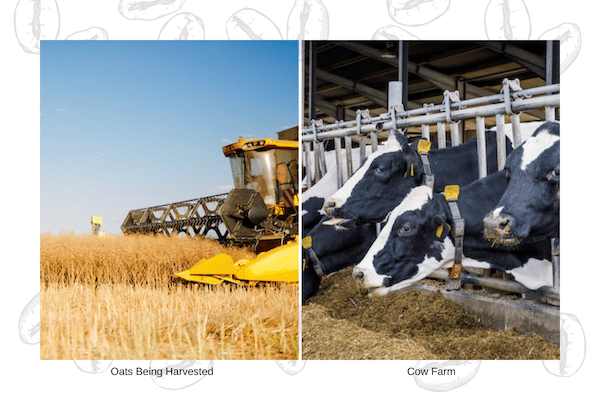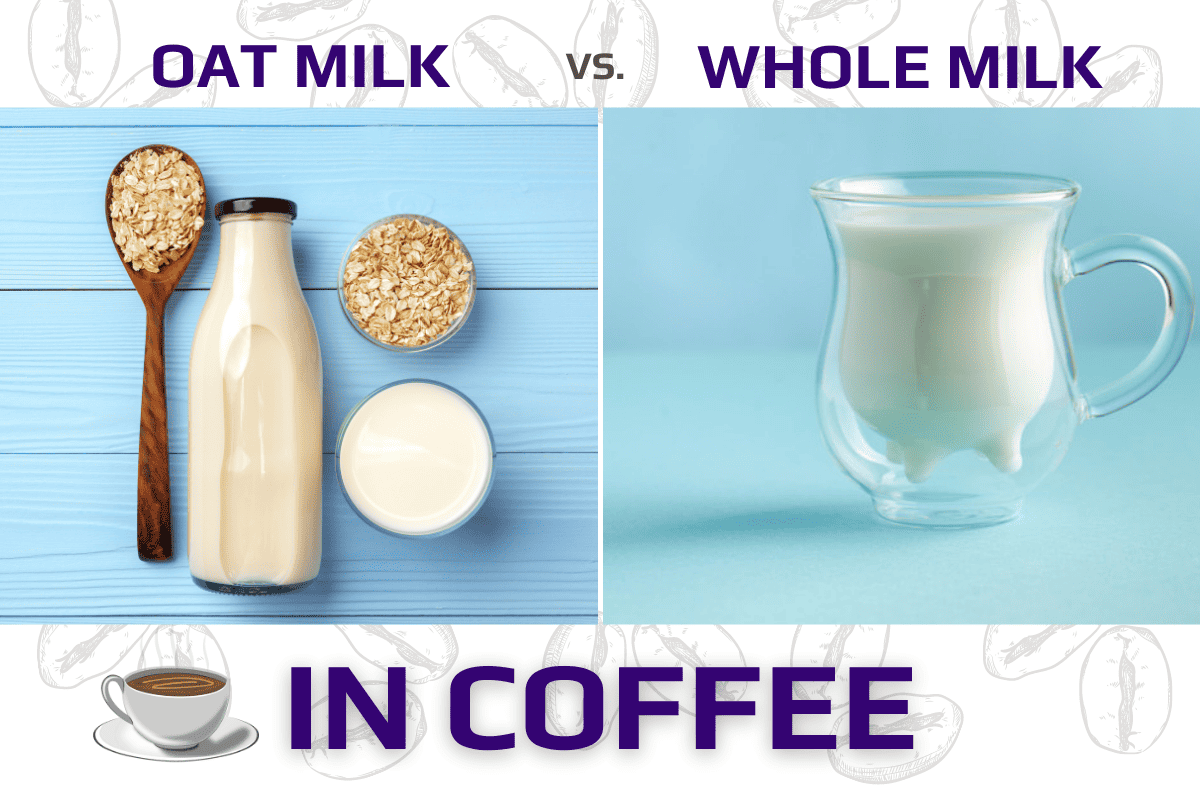When it comes to coffee, dairy milk is a common addition that many people enjoy. While dairy milk has long been the go-to choice for coffee drinkers, oat milk has gained popularity as a dairy-free alternative. This article will compare the taste, texture, nutritional value, and environmental impact of oat vs. whole milk in coffee.
Taste in Coffee: Oat Milk vs. Whole Milk
When it comes to taste, oat milk, and whole milk offer two distinct flavor profiles that can significantly impact the overall taste of your coffee.
Whole Milk Is Rich And Creamy
Whole milk has a rich, creamy flavor that can complement coffee’s bitter taste. It’s mildly sweet and doesn’t overwhelm the coffee’s natural flavors. The fat content in whole milk also contributes to a more velvety and smooth mouthfeel. Additionally, whole milk is known for its ability to balance out the acidity in coffee, resulting in a more balanced and mellow taste.
Oat Milk Is Mild & Nutty
Oat milk, on the other hand, has a mild nutty flavor that can add an earthy note to coffee. It has a sweet taste and is sweeter than other dairy-free options like soy or almond milk. The sweetness in oat milk comes from natural sugars found in oats, which are milder than whole milk. Some oat milk brands also add sweeteners and flavoring to their products, so it’s essential to check the label if you’re looking for an unsweetened version.
Oat milk can also impart a distinct oatmeal-like taste to coffee, which can be a hit or miss for some coffee drinkers. Some people find oat milk’s nutty and earthy flavor appealing and a great complement to coffee’s bold taste, while others find it too overpowering and unpleasant.
If you prefer a richer, creamier taste and texture, whole milk might be the better option for you. If you’re looking for a dairy-free alternative with a mild nutty flavor and a healthier profile, oat milk might be the way to go. It’s also worth noting that some people blend different types of milk, such as oat and whole milk, to achieve a unique taste and texture that suits their preferences.
Texture in Coffee: Oat Milk vs. Whole Milk
The texture is another important factor when choosing between oat and whole milk in coffee. The milk’s texture can affect the coffee’s overall mouthfeel and how well it mixes with the coffee.
Whole Milk Is Creamier Than Oat Milk
Whole milk has a higher fat content, which makes it thicker and creamier than oat milk. It can add richness and velvety texture to coffee. The fat in whole milk also creates a smooth, stable microfoam when steamed, making it an excellent option for lattes and cappuccinos. This microfoam adds an extra layer of texture and richness to the coffee, which some coffee drinkers find very appealing.
Regular Oat Milk Is Thinner Than Whole Milk
Oat milk, on the other hand, is thinner and has a more watery consistency than whole milk. However, some oat milk brands are formulated to froth and foam like dairy milk, making it an excellent option for cappuccinos and lattes. These specialty oat milk brands use additives like gums or carrageenan to create a thicker, creamier texture. However, not all oat milk brands froth or steam well, so check the label before purchasing. Look for a “Barista” oat milk for optimal frothing capabilities.
It’s worth noting that the texture of oat milk can vary depending on the brand and the production process. Some oat milk brands may have a more pronounced oatmeal-like texture that some coffee drinkers find unpleasant. However, other brands may have a smoother, creamier texture that complements the coffee’s taste and creates a more pleasant mouthfeel.
The texture of oat milk vs. whole milk in coffee comes down to personal preference and the type of coffee drink you’re making. Whole milk offers a richer, creamier texture that’s perfect for adding depth to lattes and cappuccinos. In contrast, oat milk can provide a lighter, nuttier texture suitable for black coffee or add a unique flavor profile to your coffee. Not to mention it is dairy and nut free. Ultimately, it’s up to you to experiment and find the milk that best suits your tastes and preferences.

How Does Oat Milk vs. Whole Milk Perform When Heated and Frothed?
Regarding heating and frothing, oat milk and whole milk can perform differently, impacting their suitability for different coffee drinks.
Whole Milk Is The OG Of Frothing
Whole milk is known for its excellent performance when heated and frothed. The higher fat content in whole milk contributes to a creamy, stable microfoam perfect for creating latte art and adding a luxurious texture to cappuccinos and lattes. The fat in whole milk also helps to stabilize the foam, making it less likely to break down or separate when heated.
Special Oat Milk Products Have Been Created To Froth Like Diary Milk
Oat milk, on the other hand, can be more challenging to froth and heat due to its lower fat content and different protein structure. However, popular oat milk brands have created unique formulas for coffee that can froth and foam just as well as whole milk. These specialty oat milk brands often include additives like gums or carrageenan to create a thicker, creamier texture that can withstand heat.
Oat milk can also be more susceptible to curdling when heated due to its higher acidity levels. It’s crucial to avoid overheating oat milk, as this can cause it to curdle or separate, resulting in an unpleasant texture and taste.
Overall, the performance of oat milk vs. whole milk, when heated and frothed, can vary depending on the brand and type of coffee drink you’re making. If you’re looking for a dairy-free option that froths and foams well, specialty oat milk brands can be great. However, whole milk may be the better choice if you’re looking for milk that’s easy to work with and produces stable microfoam.

Nutritional Value: Oat Milk vs. Whole Milk
Oat milk and whole milk are quite different nutritionally. Oat milk is generally lower in calories and fat than whole milk, making it a popular choice for those watching their weight. One cup of unsweetened oat milk contains around 120 calories and 5 grams of fat, while one cup of whole milk contains about 160 calories and 8 grams of fat.
Oat Milk Is Cholesterol Free
Oat milk is also free from cholesterol and lactose, making it a good option for those who are lactose intolerant or have high cholesterol levels. On the other hand, whole milk is a good source of protein and contains a range of naturally occurring vitamins and minerals such as calcium and vitamin D. One cup of whole milk contains around 8 grams of protein, which is important for maintaining muscle mass and supporting the immune system.
Whole Milk Contains Naturally Occurring Calcium
One important difference between oat milk and whole milk is the calcium content. While whole milk is a rich source of calcium, oat milk is often fortified with calcium to make up for its lower natural levels. In fact, many oat milk brands contain even more calcium than whole milk. Additionally, oat milk is often fortified with other nutrients such as vitamin D and vitamin B12, making it a good choice for vegans or those who follow a plant-based diet. However, oat milk is generally lower in other nutrients compared to cow’s milk.
Nutrition Comparison: Oat Milk Vs. Whole Milk
| Per 1 Cup Serving | (Oatly) Oat Milk | (Horizon) Whole Milk |
|---|---|---|
| Calories | 120 | 160 |
| Fat | 5g | 8g |
| Carbs | 16g | 13g |
| Total Sugar | 7g | 12g |
| Protein | 3g | 8g |
| Dietary Fiber | 2g | 0g |
| Calcium | 350mg | 310mg |
| Vitamin D | 3.6mcg | 4.5mcg |
Oat Milk vs. Whole Milk Ingredients
Whole milk is made from cow’s milk, while oat milk is made by soaking and blending oats with water. Oat milk may contain additives such as sweeteners, thickeners, and preservatives, so it’s important to read the label and choose a brand with minimal additives.

Environmental Impact: Oat Milk vs. Whole Milk
The environmental impact of oat milk vs. whole milk is a significant consideration for many consumers as sustainability and climate change concerns continue to grow. Here’s a closer look at how oat milk and whole milk compare in terms of their environmental impact:
Production Process:
Oat milk is generally considered to be more environmentally friendly than whole milk when it comes to production. The production of oat milk requires significantly less water and land than dairy milk. Oat milk is made by soaking oats in water, blending them, and then straining out the pulp, creating a milk-like liquid. This process is much less resource-intensive than producing dairy milk, which involves breeding, feeding, and caring for cows.
Greenhouse Gas Emissions:
Whole milk production has a higher environmental impact due to the greenhouse gas emissions associated with dairy farming. Cows produce significant amounts of methane, a potent greenhouse gas. Additionally, the production and transportation of dairy milk require a considerable amount of energy, further contributing to greenhouse gas emissions. Oat milk, on the other hand, has a lower carbon footprint than dairy milk, emitting less greenhouse gas emissions.
Water Usage:
Water usage is another significant environmental factor when comparing oat and whole milk. Dairy farming is a water-intensive process, requiring vast amounts of water for watering cows and irrigating crops to feed them. Oat milk production, by contrast, requires much less water, making it a more sustainable option.
Land Use:
Land use is another important consideration regarding the environmental impact of milk production. Dairy farming requires significant amounts of land for grazing and growing feed crops. This land use can contribute to deforestation and habitat destruction, impacting biodiversity. Oat milk, by comparison, requires much less land to produce.
Packaging:
Finally, the packaging of oat milk vs. whole milk can also impact their environmental impact. Oat and dairy milk are typically packaged in single-use containers like cartons or plastic bottles. However, some oat milk brands offer eco-friendly packaging options, such as reusable glass bottles or recyclable Tetra Pak cartons, which can help to reduce waste.
Overall, when it comes to the environmental impact of oat milk vs. whole milk, oat milk is considered to be a more sustainable option. Oat milk production requires less water and land, emits fewer greenhouse gas emissions, and has a lower overall carbon footprint than dairy milk production. However, the environmental impact can vary depending on the specific production methods and packaging used by various oat and dairy milk brands.
Final Thoughts
Overall, oat milk and whole milk both have unique characteristics when added to coffee. Whole milk has a creamy and smooth texture that many people enjoy, while oat milk has a slightly sweet and nutty taste that can complement the flavor of coffee well. Regarding nutrition, oat milk is naturally lower in fat and calories. In contrast, whole milk is a good source of calcium and vitamin D. In terms of environmental impact; oat milk is a more sustainable choice than whole milk. Ultimately, the choice between oat and whole milk in coffee comes down to personal preference and dietary needs.
Recent Posts
If you want to start a more plant-based lifestyle, one of the most accessible places to start is with your coffee. Replacing the dairy in your morning joe is an easy way to try out milk alternatives....


